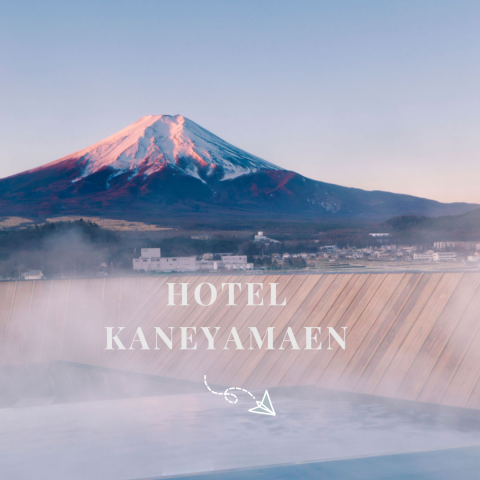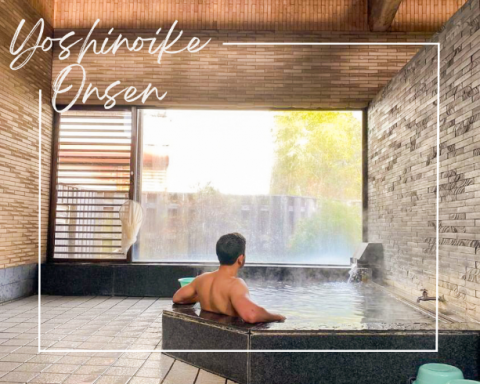Main content starts here.
This English-language text was created by Japan Tourism Agency.
Somon Gate
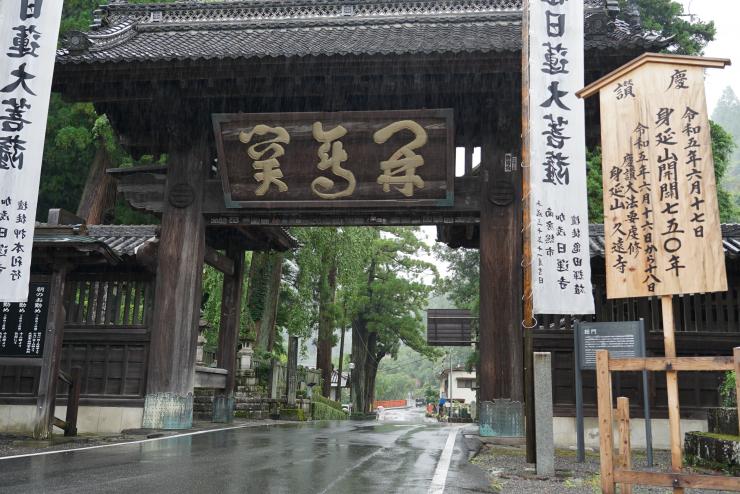
Somon, the outer gate of Kuonji Temple, was built in 1665, nearly 400 years after Nichiren Shonin first settled near Mt. Minobu in 1274. For Nichiren Buddhists, the area beyond this gate is considered sacred. It was built in front of a small rock where Nichiren Shonin would sit and rest when traveling to the mountain.
The gate is believed to have been built in fulfillment of the wishes of Miura Juouin, mother of Miura Akitaka, who was lord of Kariya Castle in Aichi Prefecture from 1724 to 1726. The Miura were a wealthy and influential family in the Mikawa area. The emblem on the gate is a circle with three horizontal lines in the center, the Miura family crest.
Niccho Shonin, the 36th head priest of Kuonji Temple, crafted the sign on the gate. The three kanji literally read “open, meeting, gate,” the essential meaning of which is: “You can become a Buddha.” It is a message to those who pass through the gate that having faith in the sacred teachings of the Lotus Sutra will open their minds and allow them to reach enlightenment.
Sanmon Gate
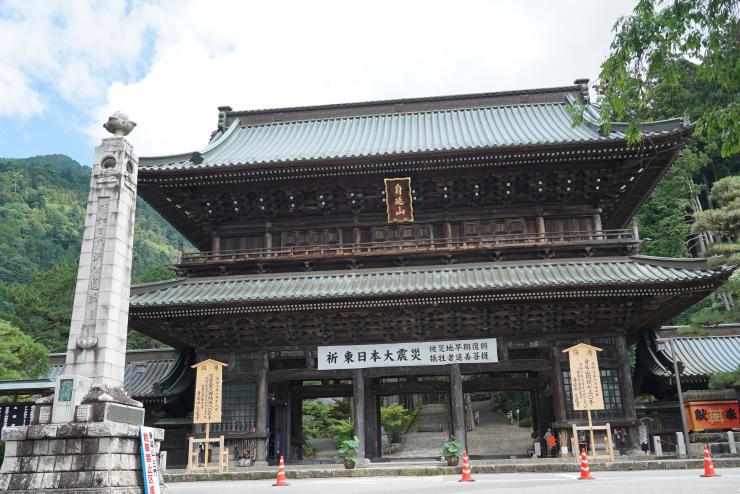
The Sanmon Gate is considered the main gate to Kuonji Temple. It was first built in 1642 and has been rebuilt three times due to fire damage over the years. A major renovation was completed in 1907.
The massive gate stands 21 meters high and 23 meters wide. It is one of the three largest gates in Japan’s Kanto region.
Temple gates with three openings (Sanmon) are also referred to as gates of the “three liberations.” Each of the three openings in the gate represents one of these liberations: kumon (emptiness), musomon (formlessness), and muganmon (inaction). It is said that passing through the Sanmon Gate can rid the believer of the three human afflictions: greed, anger, and foolishness.
Bodaitei Stairway
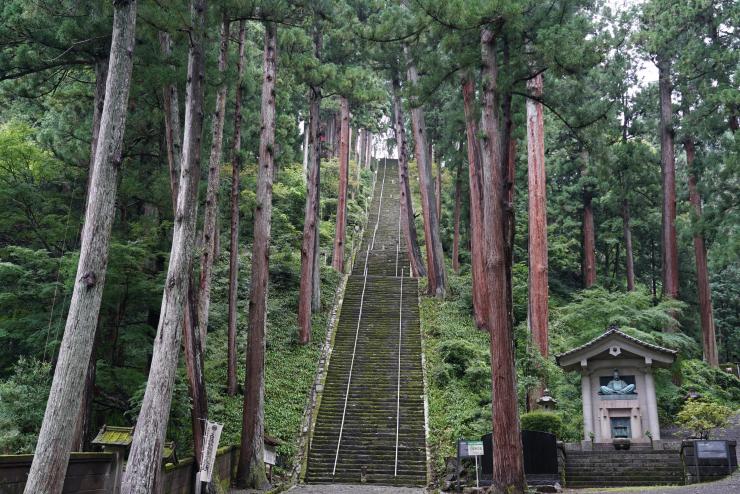
Just beyond the Sanmon Gate is an ancient staircase built in 1652. The stairway is called the Bodaitei, which means “stairway to enlightenment.” It has 287 steps, and reaches a height of 104 meters.
In 1632, a Nichiren follower named Nizo arrived at Kuonji Temple with his mother. At the time, there was no staircase leading up the slope, so Nizo had to carry his elderly mother on his back to reach the temple. At the sanctuary, Nizo prayed for the means to build a stairway to make the pilgrimage easier for Nichiren devotees. It is said that Nizo was able to save enough money from his job as a fisherman and hoped to eventually return to Kuonji and build the Bodaitei. However, while on his way to Kuonji the second time, Nizo saw many people in Fujikawa suffering from famine. He believed that the lives of others, even strangers, were more important, so he gave them the money he had saved for the stairway.
Nizo returned to his home on Sado Island and went to work again to save money. After some time, he returned to Kuonji and erected a sign offering his hard-earned money for materials and labor to help build the Bodaitei. Soon, huge crowds of people gathered to help Nizo build the staircase, many grateful to be able to earn a small income and help contribute to the experience of visiting Kuonji.
While the true reason for the number of steps is unknown, one theory is suggested by the Lotus Sutra itself. The Lotus Sutra has 28 chapters and the chant Namu myoho renge kyo is made up of 7 Chinese characters. Therefore, 28 chapters and 7 Chinese characters put together would be 287.
Many people living in the vicinity of the temple climb the Bodaitei steps for exercise as well as to seek enlightenment. After passing through the Sanmon Gate, the path to the Bodaitei acts as a time and space for contemplation. Then, climbing the stairs serves as a final challenge to reach enlightenment.
Those who wish to reach the temple without climbing the stairs will find an elevator in the parking lot that goes up to the temple ground level.
Five-Storied Pagoda
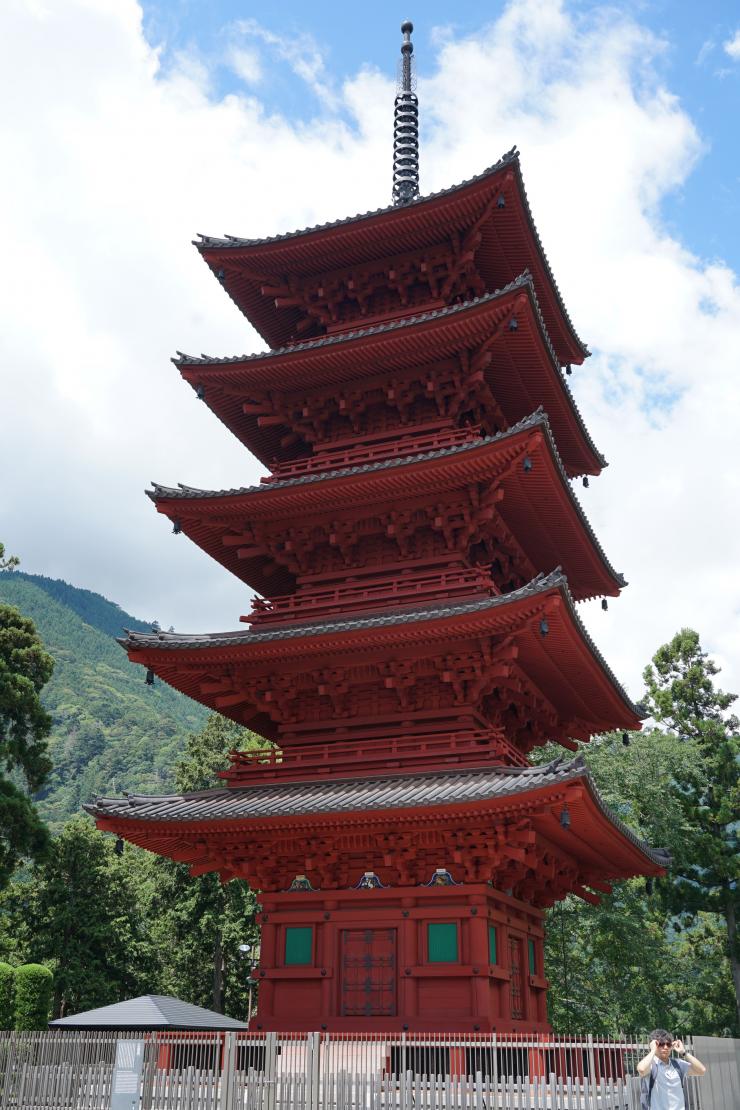
This five-storied pagoda is one of the most distinctive landmarks on Mt. Minobu. It was originally built in 1619 and once stood on the east side of Kuonji Temple. It was built by Jufukuin (1570–1631), the mother of Maeda Toshitsune, third lord of the Kaga domain (in present-day Ishikawa prefecture). At the time, this pagoda was the second tallest in Japan. It unfortunately burned down twice, once in 1829 and again in 1875.
During the Heisei era (1989–2019), the process began to rebuild the pagoda once again. Architects hoped to accurately replicate its original form. By studying its ruins, they determined the dimensions of the original. They also studied other pagodas in Japan that were built by the same original architect. In 2009, it was completed, and is now the fourth tallest pagoda in Japan, at a height of 39 meters. It is made from the wood of 400-year-old trees felled from forests on Mt. Minobu and is painted with red iron-oxide paint.
Pagodas are normally used to enshrine the ashes of Shakyamuni, the historical Buddha. This one is said to hold the ashes of Shakyamuni Buddha and also includes the Buddha statues of followers of Nichiren from all over the world.
Dragon Painting
The main hall of Kuonji Temple, known as the Hondo, is one of the most well known and beloved edifices in Nichiren Buddhism. The hall has a unique architectural design and is filled with elaborate decorations. In 1875, the main hall was lost in a large fire, but after many years the entire hall was rebuilt; the opening ceremony for the new Hondo was held in 1985. During the ceremony, the Dragon Painting (Bokuryu) was unveiled, extending across the ceiling.
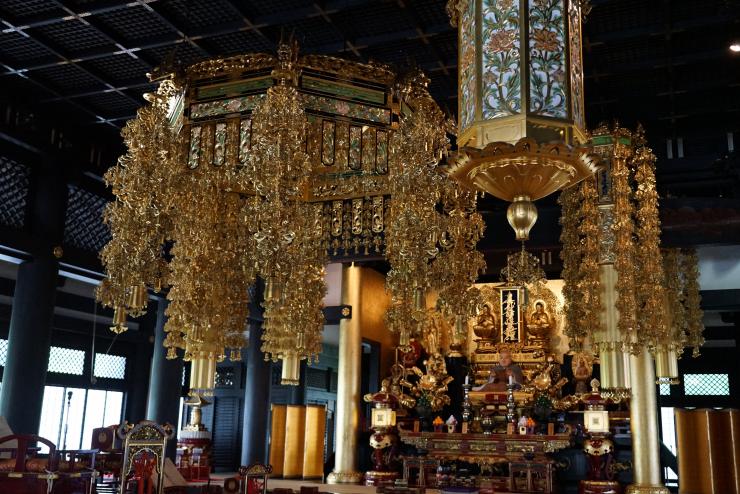
The black and white painting was created by the renowned Japanese painter Kayama Matazo (1927–2004). Kayama was an award-winning artist and professor at the Tokyo University of the Arts. Spanning 9 square meters, the painting depicts a five-clawed dragon in gold leaf. It is among the highest class of dragons and is an important mythic creature in Buddhist mythology.
The Kuonji dragon is made up of parts from nine different animals. The head is that of a camel; it has the eyes of a rabbit, the ears of a cow, and the horns of a deer. The dragon’s neck is that of a snake, its paws are those of a tiger, the talons of a hawk, the scales of a carp, and the stomach of a Komodo dragon.
The Dragon Painting was designed so that no matter where one stands in the main hall, the dragon’s eyes seem to follow the visitor. This helps create the impression that the dragon is watching over and protecting the hall.
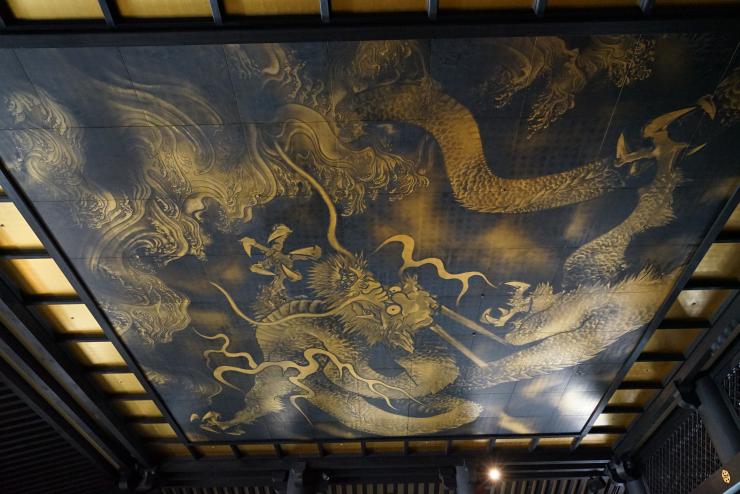
Buddhist Service in the Main Hall
Services are held within the main hall of Kuonji Temple, and visitors are welcome to take part. Every morning, 365 days a year, the monks gather for a morning prayer service that is open to the public. Guests do not need to be a Nichiren sect follower to attend, nor do they need to make a reservation or donation. Everyone is welcome.
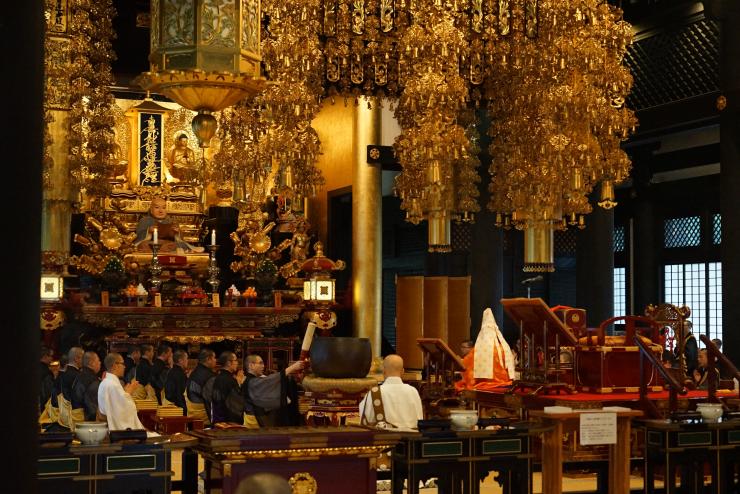
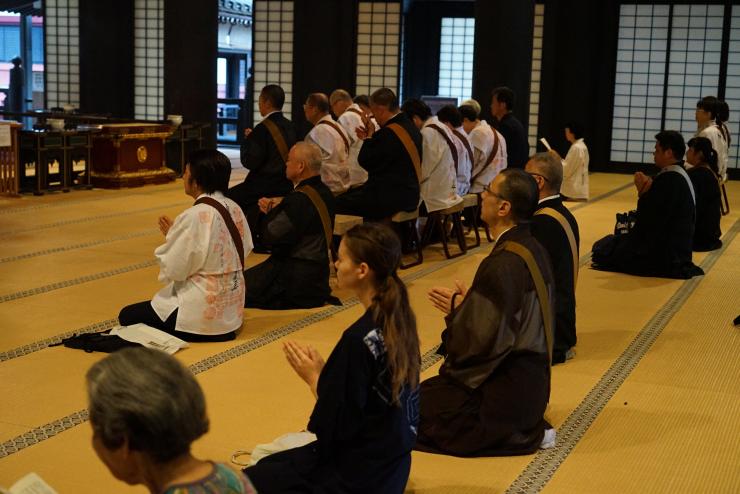
From April to September, the morning prayer service is held at 5:30 a.m. From October to March, the service is held at 6:00 a.m. The ringing of the ogane (large bell) signals the start of the service each morning. The bell was built in 1624 under the supervision of Kuonji’s 21st head priest, Nichikan Shonin.
In the sixteenth century, a Nichiren priest named Dojun traveled across Japan to raise funds to build the bell but died before achieving his goal. Fortunately, Yojuin (1577–1653), a member of Tokugawa Ieyasu’s concubine, made a large donation to complete the fundraising for the bell.
Visitors who arrive early will observe the ringing of the bell. In order to pull the bell’s striking beam back far enough, the monk must perform the difficult feat of holding on to the rope and balancing on the bell tower’s ledge with his body parallel to the ground.
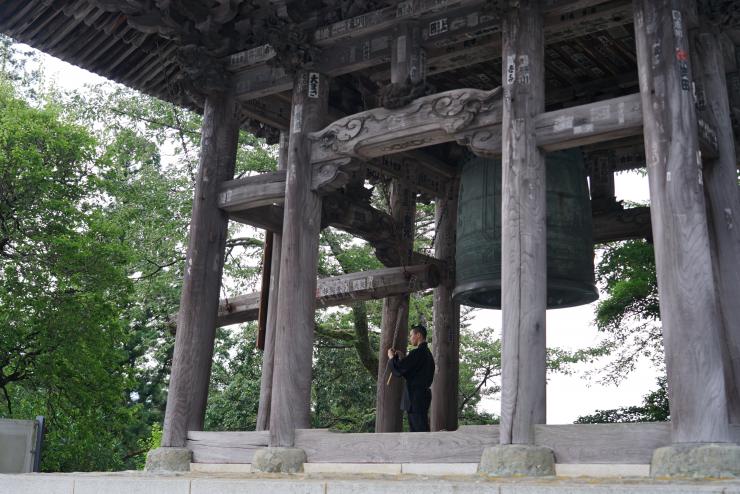
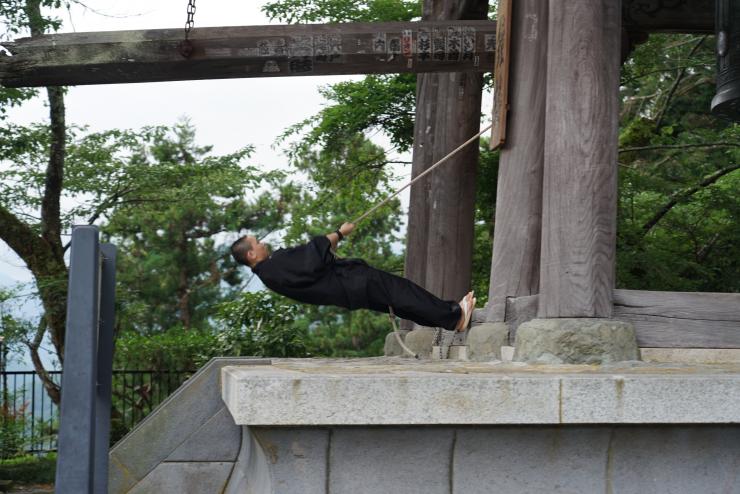
During the morning service, around fifty monks and the head priest gather and recite verses from the Lotus Sutra. Two monks beat large taiko drums as the monks enter and are seated in the middle of the hall. The entire service is rhythmic and mystical. During the ceremony, the monks strike bells and wooden percussion instruments to help maintain and enhance the rhythm of their chants.
Visitors may enter through the front doors and take a seat anywhere in the open space in front of the altars. Some sit in the traditional seiza (kneeling) position, while others sit cross-legged. Chairs are available near the front entrance.
The service usually follows the standard format used in Nichiren temples:
1. Invocation: prayers offering an invitation to the Buddha, Dharma, and assembly to be present at the service
2. Kaikyoge: verses for the opening the Lotus Sutra
3. Recitation of Chapter 2 of the Lotus Sutra
4. Recitation of Chapter 16 of the Lotus Sutra
5. Chanting Odaimoku: Namu myoho renge kyo (I take refuge in the Lotus Sutra.)
6. Reciting Hotoge: a verse from The Lotus Sutra that has a special beat
7. Prayer: The head priest offers prayers for those who are suffering around the world and for current issues, domestic and global. It is also possible to request a specific prayer be read during the ceremony for, as one example, loved ones who are ill. For most of the ceremony, the head priest sits with his back to the congregation. For the Prayer, the priest will turn to face those in attendance for the first time in the ceremony and address them directly. He delivers a short sermon before returning to his seat and concluding the service.
8. Reciting the Four Great Vows:
Sentient beings are innumerable; I vow to save them all.
Our evil desires are inexhaustible; I vow to quench them all.
The Buddha’s teachings are immeasurable; I vow to study them all.
The way of the Buddha is unexcelled; I vow to attain the path sublime.
After the recitation of The Four Great Vows, the monks file out of the room as large taiko drums mark the end of the service. One monk then approaches the crowd with a box filled with ofuda, which are talismans for protection or good luck that visitors can take home.
Once the ceremony is over, visitors can also visit the Soshido, a large hall next to the main hall. Visitors will notice a striking color contrast between the Soshido and the main hall: the main hall has a mostly black exterior, whereas the Soshido is red. A statue of Nichiren Shonin is enshrined at the Soshido, as well as statues of Nichiren’s parents and six senior disciples.
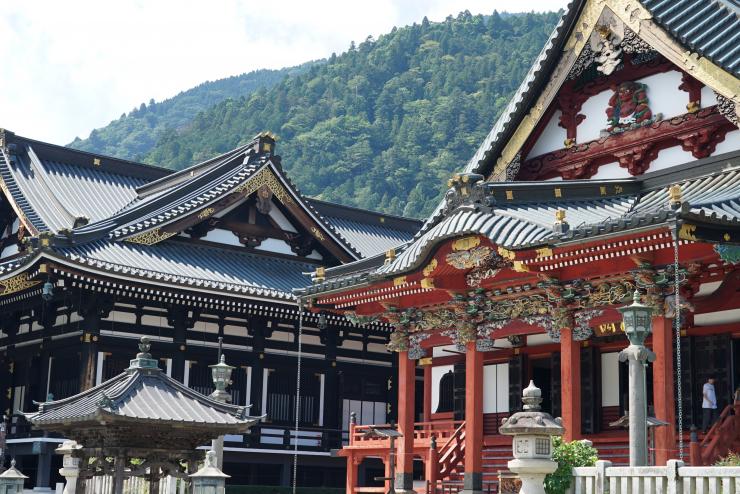
Goshinkotsudo Hall
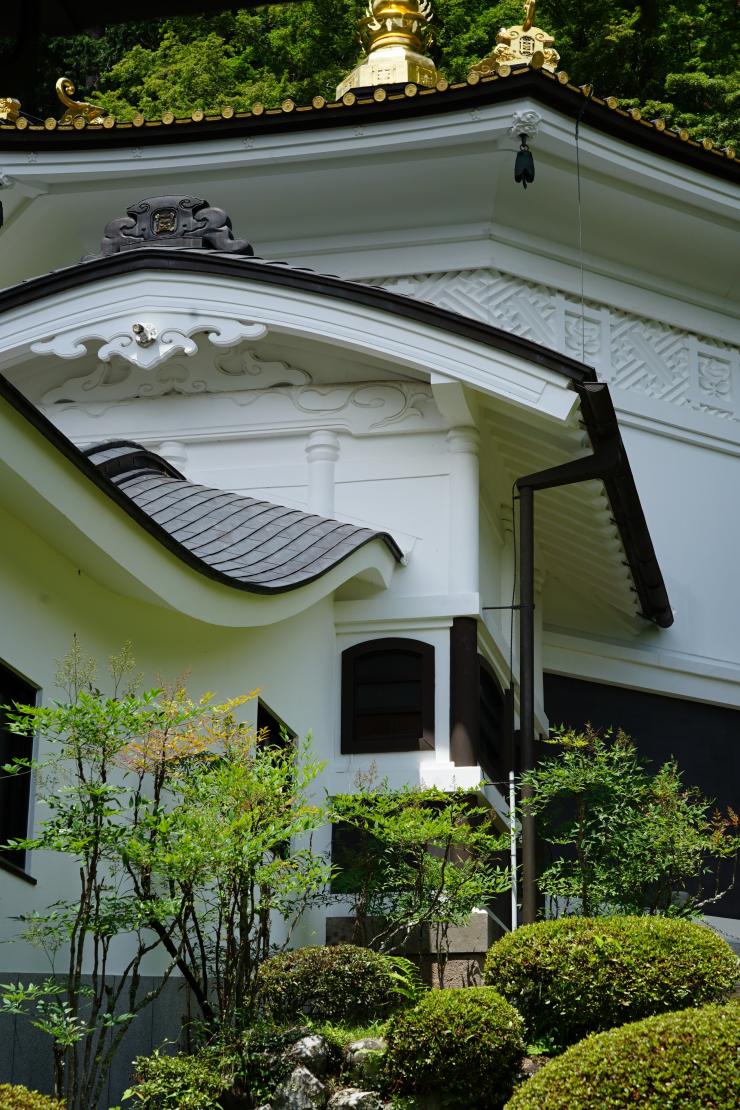
Before Nichiren passed away, he wrote this message in his will: “Please build my grave on Mt. Minobu, where my heart will forever reside.” His disciples honored his wish and built Goshinkotsudo, a mausoleum that enshrines Nichiren’s ashes and is thus his official gravesite. It is considered one of Kuonji Temple’s most sacred places.
Goshinkotsudo was built in 1881 with the donations of Nichiren Buddhists from Owari (present-day Aichi Prefecture). The hall has a five-storied pagoda in the center, within which is an urn that holds Nichiren’s remains. The pagoda was donated by the Nagasaki Nichiren Buddhist Association. The hall burned down in 1886 but was quickly rebuilt.
The mausoleum has an octagonal design. Circles are associated with reincarnation in Buddhist mythology, but circular buildings are too difficult to construct. Furthermore, the building is designed so that it can be lowered underground in case of major earthquakes or fires.
Anyone can visit the Goshinkotsudo, but the inner sanctum is not open to the public, and most monks are also not permitted to enter this hallowed place.
Shishinkaku Hall
During the Kamakura period (1185–1333), devoting one’s life to the Buddhist priesthood and pursuing enlightenment meant cutting oneself off from past ties. It also meant leaving behind parents and other family members. During his life of devotion, Nichiren often missed his parents and former teachers in his hometown. He would climb to the top of Mt. Minobu and pray for his deceased parents and Buddhist mentor, both of whom were buried in present-day Chiba Prefecture.
Since Nichiren had many enemies both in the government and in rival Buddhist schools, he was not able to return to his hometown often. As a result, he could not be at his parents’ side when they were dying. It is said that this was one of Nichiren’s deepest regrets. To honor his parents, Nichiren had Shishinkaku Hall (lit., “hall of parental remembrance”) built on top of Mt. Minobu.
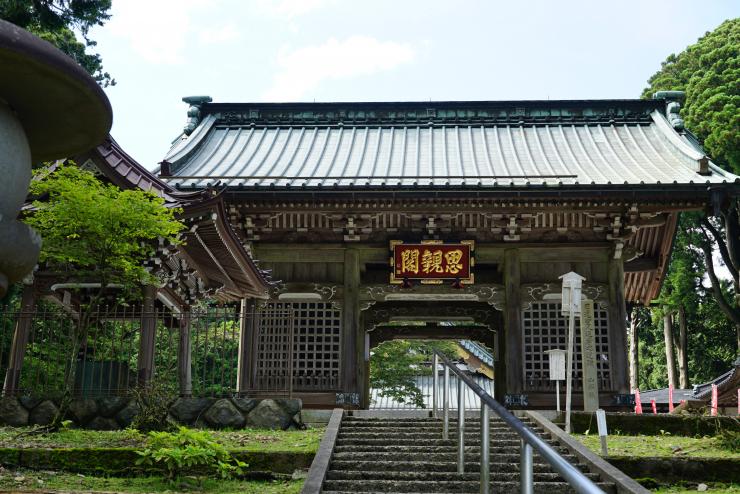
The Mt. Minobu summit where Nichiren would think of his parents is called the “summit of familial bonds.” Near the hall are four large cedar trees said to have been planted by Nichiren himself. He planted the first two trees in honor of his mother and father, the third tree for the doctor who lived with him near Mt. Minobu, and the fourth in honor of the whole country.
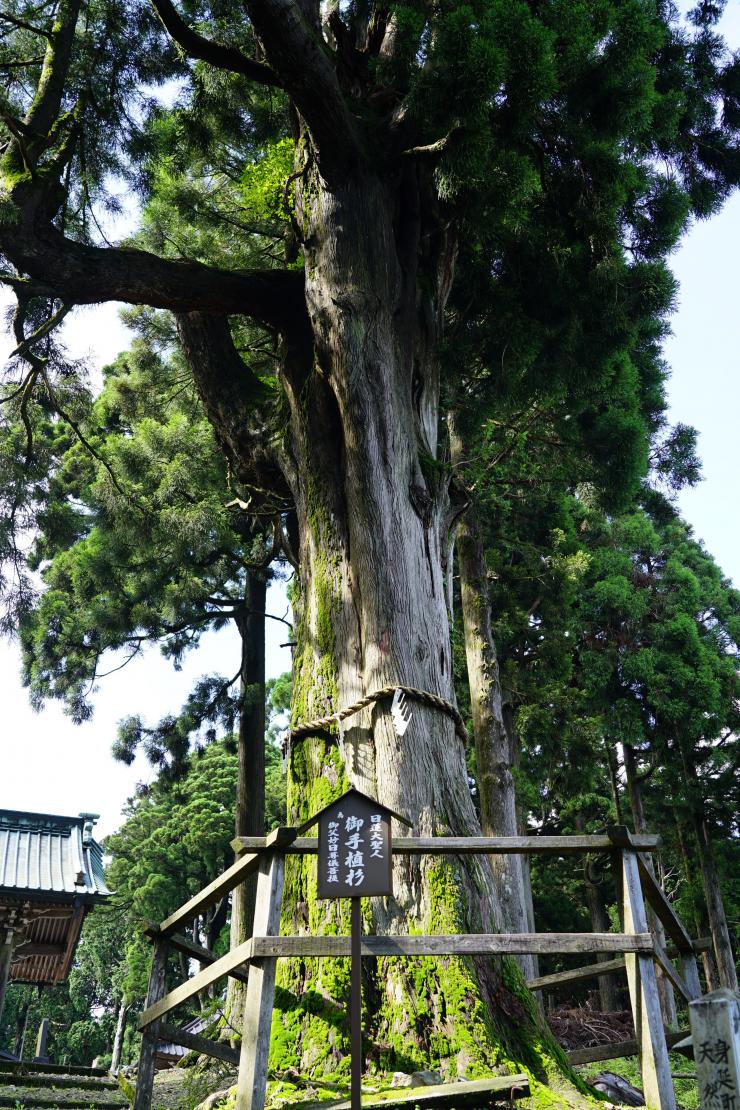
To reach Shishinkaku, visitors can take a cable car from Kuonji Temple to the top of Mt. Minobu, which rises to a height of 1,153 meters. The ride to the top takes around seven minutes. On the temple grounds is a souvenir shop that serves fresh dango (sweet rice dumplings). The nearby vista point affords a fine view of Mt. Fuji to the east on clear days. The phenomenon known as “Diamond Fuji,” during which the sun rises directly above the peak of Mt. Fuji, creating an effect as if a sparkling diamond is sitting on the peak, can be observed in the early morning from March to September.
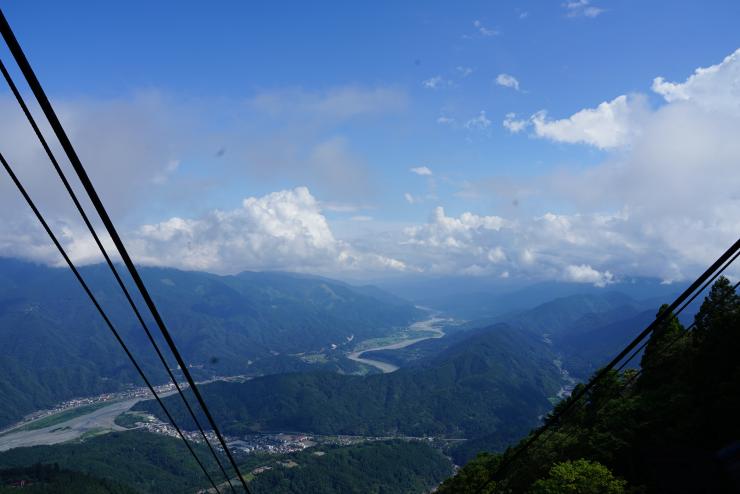
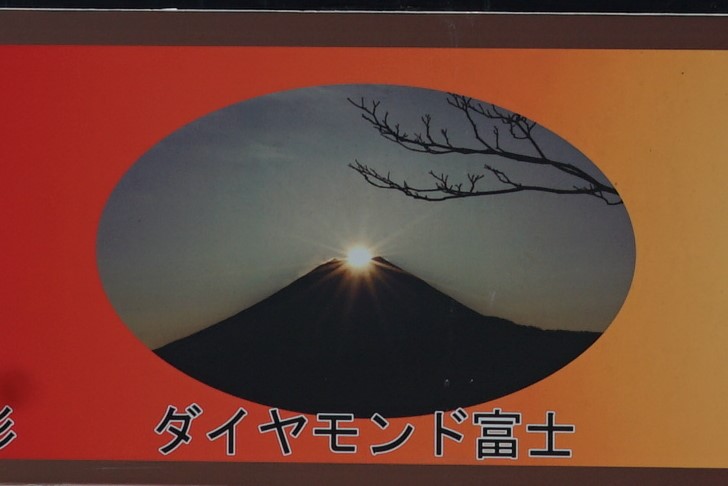
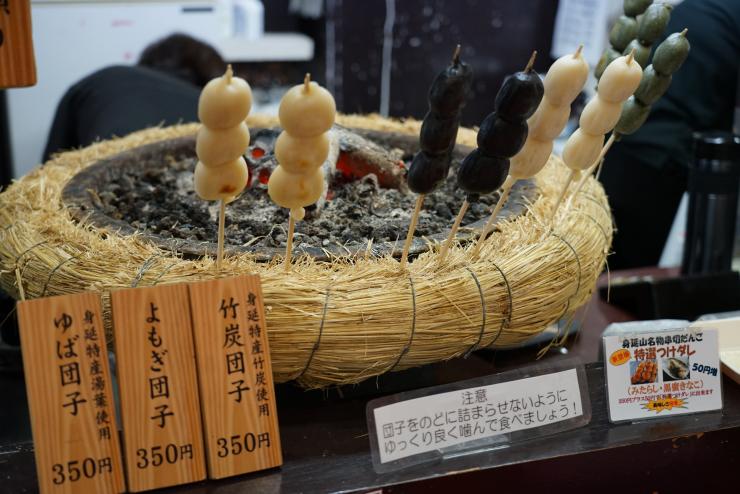
Gosoan Site
This location marks the site of Nichiren’s hut on Mt. Minobu, where he sought asylum after leaving Kamakura. Beginning in 1274, he lived here under the protection of Hakiri Sanenaga (1222–1297) until his death in 1282.
It was here that Nichiren spent his final eight years reading, writing, and training his disciples. Nichiren read the Lotus Sutra extensively and wrote most of his scriptures at Gosoan. He developed the founding principles of the sect here.
The low stone walls surrounding the empty plot of grass were built with a donation by Lady Kenju-Inden, the wife of Lord Sakai of Himeji. This was the location of the hut where Nichiren once lived. The Gosoan site is also considered the birthplace of Kuonji Temple, founded by Nichiren.
Near Gosoan-ato is Gobyosho, a tomb that holds a portion of Nichiren’s ashes. This is the tomb where his ashes were brought after his funeral. Gobyosho is an octagonal-style pagoda made of marble. His ashes are stored both in the Goshinkotsudo Hall of Kuonji Temple and in this pagoda. The pagoda is inscribed with Nichiren’s mantra Namu myoho renge kyo.
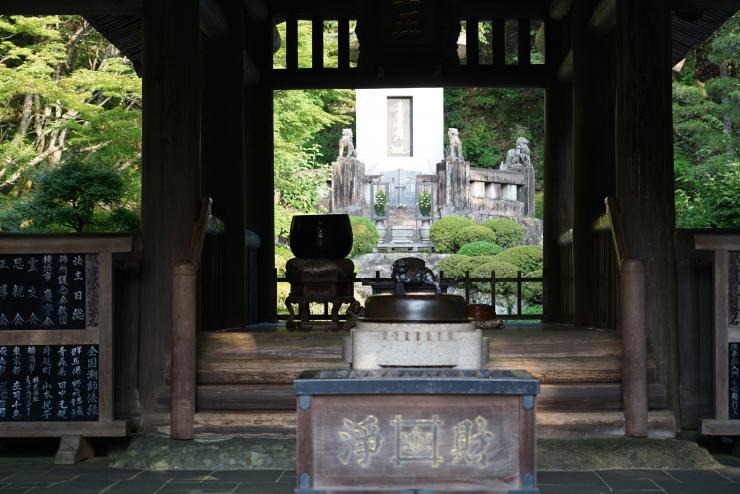
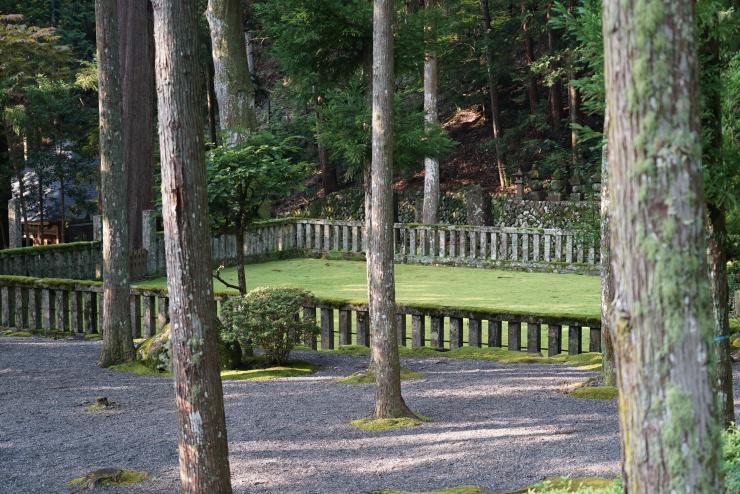
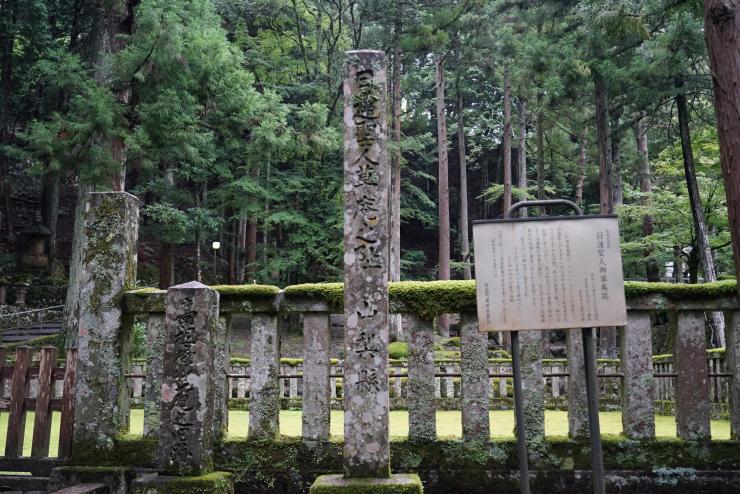
Shizuku no Sakura
The Shizuku no Sakura (“Dewdrop Cherry”) tree is located near the site of Gosoan, Nichiren’s hut on Mt. Minobu. The tree is estimated to be around 700 years old and is thus one of the oldest blossoming cherry trees in Yamanashi Prefecture.
Here is the story behind this ancient tree. Gosoan was the hut where Nichiren spent most of his eight years on Mt. Minobu. It is where he ate, slept, and wrote his treasured works. It is also where he tutored his disciples and gave sermons. Near Gosoan, a man named Inababo lived in a village called Shimoyama-go. Inababo heard about Nichiren and his disciples and would go to Gosoan every night to listen to his teachings. According to the legend, Inababo hid behind the cherry trees near Nichiren’s home in order to listen to his sermons.
Inababo would listen late into the night, so late that the evening dewdrops from the cherry tree would fall onto his clothes. Thus, the Shizuku no Sakura tree was given its name, and Inababo eventually became one of Nichiren’s closest disciples.
Also near the tree is the Gobyosho, which holds a portion of Nichiren Shonin’s ashes. For those coming to Mt. Minobu to view the cherry blossoms, the Shizuku no Sakura and the 400-year-old weeping cherry trees of Kuonji Temple are among the main attractions.
Minobusan Kuonji Museum
Minobusan Kuonji Temple has a rich history of over 700 years, dating back to the end of the Kamakura period (1185–1333). A Treasure Hall was built in 1926 to house the centuries-old paintings, scriptures, and artifacts in the temple’s collection. As part of the Nichiren Shonin 700th Anniversary Project in 1985, the Minobusan Kuonji Museum was built in the basement of the main hall; the artifacts were then moved from the Treasure Hall to the Museum.
The collection contains about 5,000 items, and strict rules and permissions are required for borrowing items by other institutions. In 1973, through collaboration with the Agency for Cultural Affairs, the Prefectural Board of Education, and Minobusan Junior College, the items were catalogued by the Minobu Library of Documents and Paintings.
Some of the most famous paintings on display include the Mandala Honzon, completed in 1281, and the Mikage of Hakiri, a portrait of Nichiren Shonin dating to 1282. Other famous works include Saint Nichiren by Sumiyoshi Jokei (1599–1670). The museum also houses paintings by various Chinese artists and works of original calligraphy by Tokugawa Ieyasu and members of his family.
With all these important paintings, scriptural items, and artifacts, the museum attracts around 60,000 visitors annually.
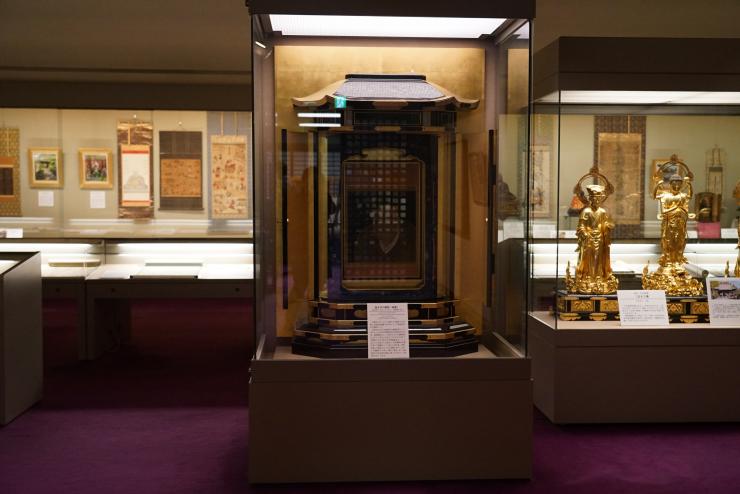
The admission fee also gives visitors access to the museum’s Sutra Calligraphy Experience, where they can try their hand at traditional Japanese calligraphy by tracing over the lines of sutras revered by the Nichiren sect. English instructions are not necessary: simply use the brush to trace the kanji shown in pale ink on the page. Even Japanese language beginners can participate.
Please note that photography is not allowed in the museum.
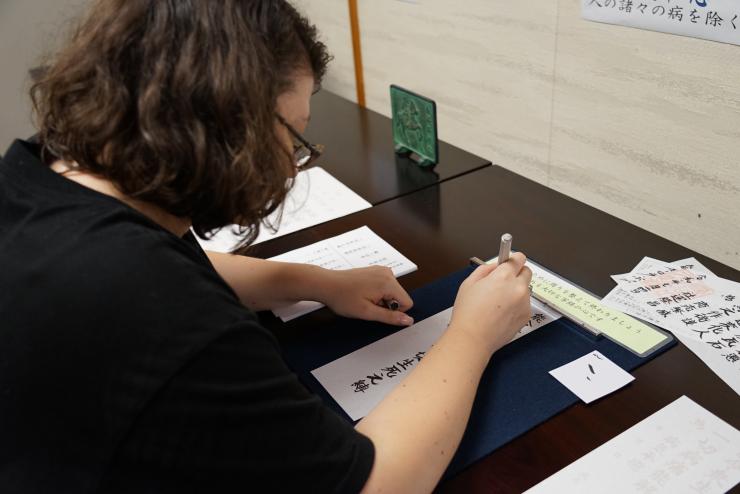
Mt. Minobu Weeping Cherry Trees
Spring in Japan is marked by the enjoyment of cherry blossoms around the country, and the Mt. Minobu area is no exception. The area is dotted with shidare zakura (weeping cherry trees), which bloom in shades of white and light pink.
Near Kuonji Temple are two 400-year-old weeping cherry blossom trees. One stands in front of the Soshido, the large red hall that houses the statues of Nichiren, his parents, and his disciples. The other tree stands in front of the temple’s guesthouse. While Japan is filled with beautiful cherry trees, only a few have been standing since the beginning of the seventeenth century.
With Kuonji Temple in the background, the weeping cherries and, in particular, the two 400-year-old trees are among the most popular attractions in Yamanashi. Their beauty has also been featured on the national news.
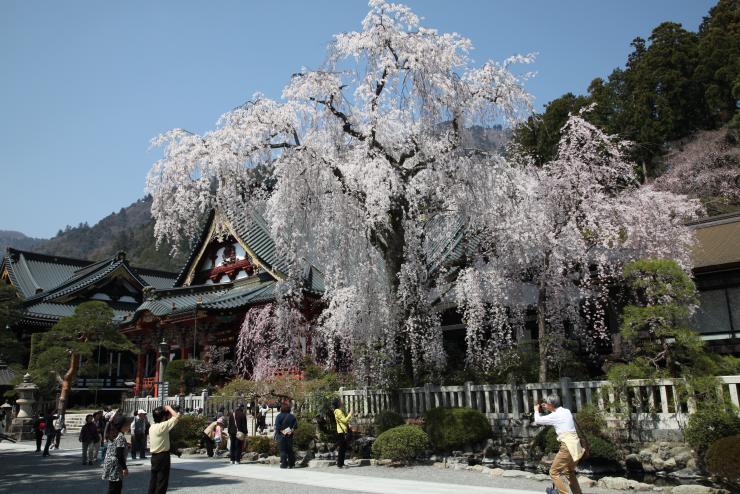
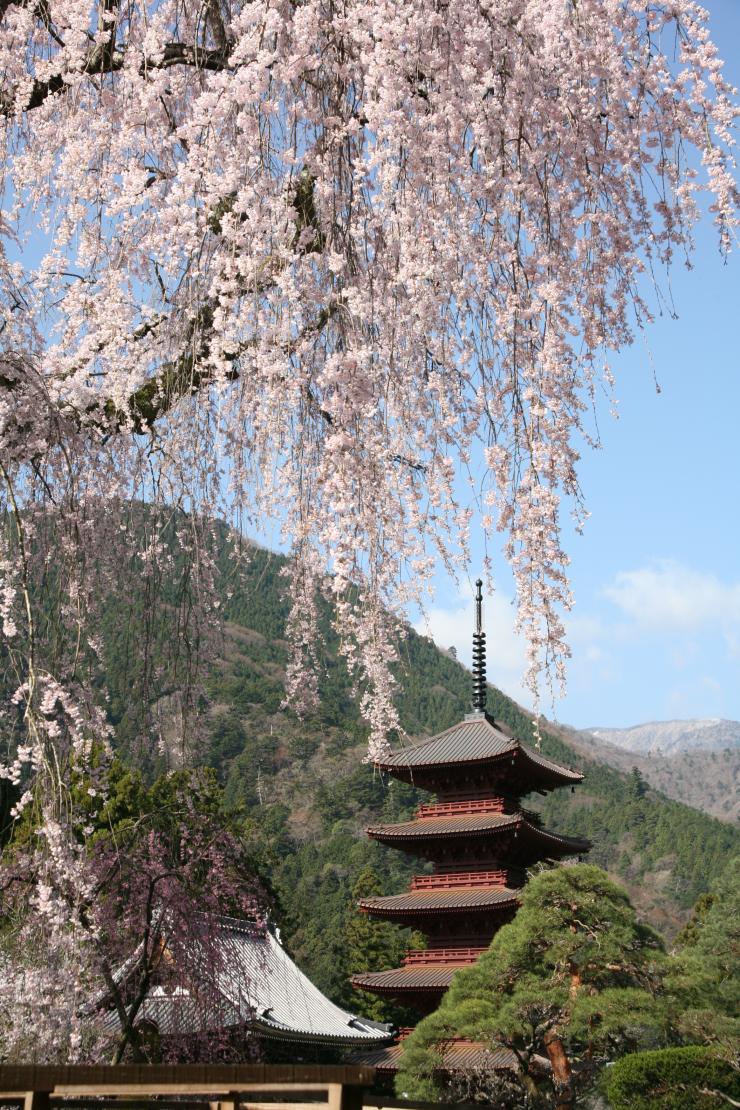
Published on
- April 14, 2022
Share
-
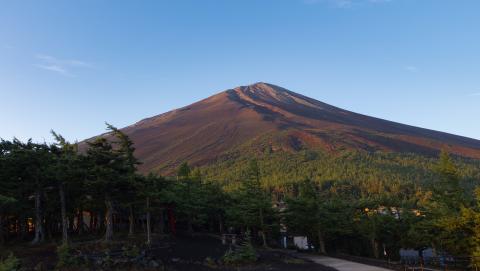
Fuji Subaru Line 5th Station & Mt. Fuji Travel Guide
March 3, 2025
Home of Mt. Fuji > Staff Journal > Mt. Minobu Kuonji Temple
